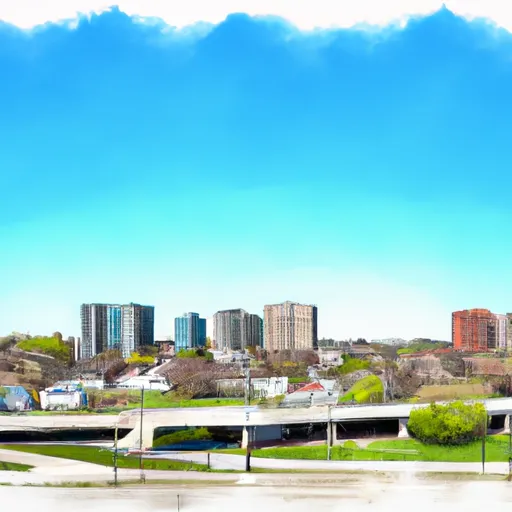-
 Snoflo Premium
Snoflo Premium
Get unlimited access to all our content
With no Ad interruptions! - Start Your Free Trial Login with existing account
Lincolnwood
Eden Index
Climate
7.7
•
Recreation
4.2
•
Community
4.0
•
Safeguard
5.6/10

Located in Cook County, Illinois, Lincolnwood is a small village with a population of about 12,000 residents. The climate in Lincolnwood is characterized by warm summers and cold winters. Average summer temperatures range from 70-85°F, while winter temperatures hover around 15-35°F. Precipitation is relatively evenly distributed throughout the year, with an average of 36 inches annually.
Lincolnwood is not known for any significant hydrological features. However, the village does have several parks and green spaces that offer outdoor recreation opportunities. Proesel Park, for example, boasts walking paths, picnic areas, and sports fields. The 71-acre Laramie Park also offers playgrounds, tennis courts, and a swimming pool. Additionally, the nearby Skokie Lagoons, just a short drive away, provide scenic walking trails, fishing spots, and opportunities for canoeing and kayaking.
While Lincolnwood itself may not have any notable hydrological features, its proximity to parks and recreational areas allows residents and visitors to engage in a variety of outdoor activities, making it a desirable place for nature enthusiasts and those seeking recreational opportunities in the area.
What is the Eden Index?
The Snoflo Eden Index serves as a comprehensive rating system for regions, evaluating their desirability through a holistic assessment of climate health, outdoor recreation opportunities, and natural disaster risk, acknowledging the profound impact of these factors on livability and well-being.
Climate Health Indicator (CHI): 7.7
Lincolnwood receives approximately
948mm of rain per year,
with humidity levels near 83%
and air temperatures averaging around
10°C.
Lincolnwood has a plant hardyness factor of
5, meaning
plants and agriculture in this region thrive during a short period during spring and early summer. Most
plants will die off during the colder winter months.
By considering the ideal temperature range, reliable water supplies, clean air, and stable seasonal rain or snowpacks, the Climate Health Indicator (CHI) underscores the significance of a healthy climate as the foundation for quality living.
A healthy climate is paramount for ensuring a high quality of life and livability in a region, fostering both physical well-being and environmental harmony. This can be characterized by ideal temperatures, reliable access to water supplies, clean air, and consistent seasonal rain or snowpacks.
Weather Forecast
Streamflow Conditions
Upper Illinois
Area Rivers
Upper Illinois
Snowpack Depths
Upper Illinois
Reservoir Storage Capacity
Upper Illinois
Groundwater Levels
Recreational Opportunity Index (ROI): 4.2
The Recreational Opportunity Index (ROI) recognizes the value of outdoor recreational options, such as parks, hiking trails, camping sites, and fishing spots, while acknowledging that climate plays a pivotal role in ensuring the comfort and consistency of these experiences.
Access to outdoor recreational opportunities, encompassing activities such as parks, hiking, camping, and fishing, is crucial for overall well-being, and the climate plays a pivotal role in enabling and enhancing these experiences, ensuring that individuals can engage in nature-based activities comfortably and consistently.
Camping Areas
| Campground | Campsites | Reservations | Toilets | Showers | Elevation |
|---|---|---|---|---|---|
| Crawford County Fairgrounds | None | 508 ft | |||
| Robinson City Park | None | 541 ft | |||
| Red Hills Lake State Park | 130 | 519 ft | |||
| Kimmell City Park | 10 | 415 ft | |||
| Lincoln Trail State Park | 240 | 655 ft | |||
| Lincoln Trail | None | 412 ft | |||
| Mill Creek Park | 140 | 657 ft | |||
| Bumpus Mills - Lake Barkley | None | 520 ft | |||
| Oblong Park | None | 491 ft | |||
| Ouabache Trails County Park | 45 | 446 ft |
Nearby Ski Areas
Catastrophe Safeguard Index (CSI):
The Catastrophe Safeguard Index (CSI) recognizes that natural disaster risk, encompassing floods, fires, hurricanes, and tornadoes, can drastically affect safety and the overall appeal of an area.
The level of natural disaster risk in a region significantly affects safety and the overall livability, with climate change amplifying these risks by potentially increasing the frequency and intensity of events like floods, fires, hurricanes, and tornadoes, thereby posing substantial challenges to community resilience and well-being.
Community Resilience Indicator (CRI): 4.0
The Community Resilience Indicator (CRI) recognizes that education, healthcare, and socioeconomics are crucial to the well-being of a region. The CRI acknowledges the profound impact of these elements on residents' overall quality of life. By evaluating educational resources, healthcare accessibility, and economic inclusivity, the index captures the essential aspects that contribute to a thriving community, fostering resident satisfaction, equity, and social cohesion.

